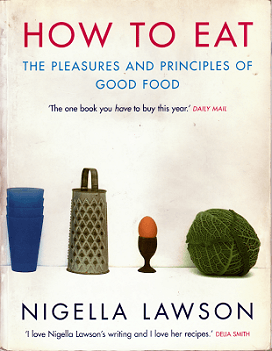How to Eat facts for kids

First edition
|
|
| Author | Nigella Lawson |
|---|---|
| Country | England |
| Subject | Cookery |
| Publisher | Chatto and Windus |
|
Publication date
|
1998 |
| Pages | 514 |
How to Eat is a popular cookbook from 1998. It was written by the famous English cook, Nigella Lawson. This book shares many helpful cooking tips. It shows how to prepare food and save time in the kitchen. The book sold over 300,000 copies in Britain. People who reviewed the book said it was a great guide for cooking.
Contents
About the Book "How to Eat"
Nigella Lawson's Approach to Cooking
Nigella Lawson starts her book by saying, "I am not a chef." She means she isn't trying to invent brand new, super fancy dishes. Instead, her main goal is to make you feel like she is cooking right there with you. She wants to make cooking easy and fun for everyone.
The book is split into different chapters. Each chapter has a special theme, like "Cooking for One or Two." Most of each chapter is filled with recipes. But before the recipes, there are a few pages of general advice. This advice is about the chapter's theme.
How Recipes Are Written
Every recipe in the book has a clear name. Most names are in English, but some use foreign words if needed, like "Pea Soufflé."
Each recipe begins with a short paragraph. This part gives advice on the dish. For example, the "Scallops and Bacon" recipe explains that it is:
just the right balance between nursery comfort and dining-room elegance and takes hardly any time to cook
After this, there is a paragraph about buying and storing the ingredients.
The ingredients and how much you need are listed clearly. They are shown in bold red text. The cooking steps are then given as a paragraph of instructions. These instructions are easy to follow.
Cooking Techniques and Tips
Nigella Lawson sometimes uses new ways to cook. She does not always follow old, strict traditions. For example, in her recipe for Ratatouille, she changes a classic method. The original recipe, brought to Britain by Elizabeth David, asks you to salt the aubergine and courgettes for an hour. This step is supposed to stop them from getting soggy.
However, Lawson found that skipping this step did not make much difference. She still got a good result without a "soggy mush." She does explain the traditional method in a side note. This way, readers can choose to try it if they want to.
What's Inside the Book
The book has many useful sections. Here are some of them:
- Charts & Conversions
- Basics etc.
- Cooking in advance
- One and Two (for cooking for a small number of people)
- Fast food
- Weekend lunch
- Dinner
- Low fat
- Gazetteer (a list of places or terms)
- Bibliography (a list of other books used)

